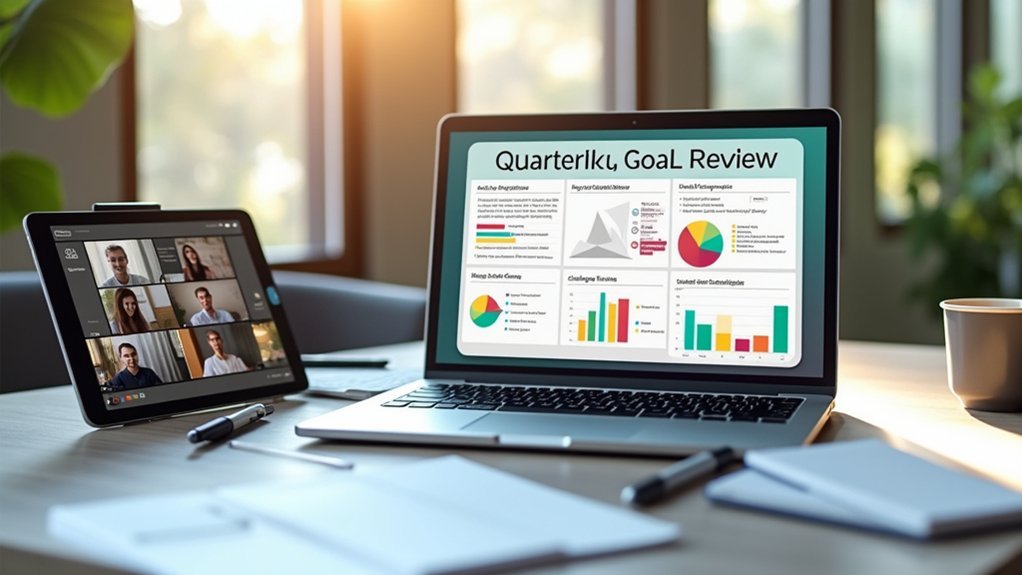In the labyrinth of remote work, have you ever felt lost tracking team performance? Quarterly goal review templates aren’t just paperwork—they’re your strategic compass for steering dispersed workforce accountability. You’ll want a systematic approach that transforms scattered efforts into cohesive progress. These templates bridge communication gaps, ensuring every team member stays aligned with organizational objectives. Curious how a well-designed template can revolutionize your remote team’s productivity and engagement?
Key Takeaways
- Virtual collaboration platforms enable comprehensive, structured quarterly goal review templates that facilitate transparent performance tracking for distributed teams.
- Cloud-based review documents with pre-defined sections allow remote employees to input self-assessments, achievements, challenges, and development objectives seamlessly.
- 360-degree feedback mechanisms integrated into digital templates provide holistic performance insights by collecting perspectives from multiple team members and stakeholders.
- Standardized goal-tracking sections within review templates should include quantifiable metrics, progress percentages, and specific action items for continuous improvement.
- Interactive digital templates with real-time collaboration features support dynamic discussions, enabling managers and team members to co-create meaningful performance development strategies.
The Purpose of Quarterly Performance Reviews

While traditional annual performance reviews often feel disconnected and impersonal, quarterly performance reviews offer a dynamic, responsive approach to tracking employee progress and organizational alignment. The quarterly performance review process allows you to systematically assess your employee’s performance, identifying goals and areas that need improvement. Performance reviews provide an opportunity to deliver constructive feedback, helping team members understand their strengths and growth opportunities. By conducting these reviews every quarter, you’ll create a structured environment where you can celebrate wins and develop targeted action plans. Effective quarterly performance reviews transform sporadic evaluations into a continuous improvement cycle, ensuring that individual objectives remain closely aligned with broader team and organizational strategies.
Key Components of an Effective Review Template

Every successful quarterly performance review template serves as a strategic roadmap for tracking performance and driving continuous improvement. Your template must capture critical elements that provide objective insights:
Performance reviews are strategic roadmaps that transform workplace insights into actionable growth opportunities.
- Thorough performance metrics that quantify employee contributions
- Dedicated sections for accomplishments, challenges, and areas for improvement
- Structured space for employee self-reflection and professional development goals
A well-designed template encourages accountability by incorporating:
- Clear action items with specific deadlines
- Assigned ownership for future objectives
- Peer feedback mechanisms to enhance team dynamics
Preparing for the Quarterly Review Meeting

Transforming a performance review template into a productive meeting requires strategic preparation. You’ll need to gather relevant data like KPI reports and project updates to inform meaningful discussions. Share the review template with team members well in advance, allowing them time to prepare thoughtful contributions.
Set a clear agenda with precise time allocations for each topic, ensuring a structured quarterly meeting. Designate specific roles to facilitate engagement and encourage participation from all team members. Prepare targeted questions that guide conversations around performance, progress, and upcoming goals.
Employee Self-Assessment Strategies
Because effective quarterly reviews rely on honest self-reflection, employee self-assessment strategies play a critical role in driving professional development and organizational alignment.
When implementing performance management, consider these key strategies:
- Use a structured self-evaluation template that allows you to systematically assess your job knowledge and contributions
- Provide specific examples of achievements and challenges to facilitate targeted feedback
- Align your goals with your direct reports to demonstrate strategic thinking
Your Performance Review Meeting Template should encourage you to critically analyze where you can improve. By proactively preparing your quarterly performance review meeting materials, you’ll create an opportunity for positive and constructive dialogue. These employee self-assessment strategies empower you to take ownership of your professional growth, ensuring that each review becomes a meaningful conversation about your progress and potential.
Conducting Meaningful Performance Discussions
When managers approach quarterly performance discussions with intentionality, they create powerful opportunities for employee growth and organizational alignment. By utilizing a structured employee review template, you’ll guarantee that performance discussions remain focused and strategic. The “stop, start, and continue doing” feedback method provides a clear understanding of an employee’s strengths and development areas, helping you effectively assess an employee’s performance.
Encourage open dialogue by inviting team members to share insights and ask questions during reviews. This collaborative approach alleviates anxiety and promotes transparent communication. Follow up each discussion with specific action items and regular check-ins to reinforce accountability. Through systematic quarterly reviews, you’ll drive continuous improvement, address potential performance issues, and maintain alignment with organizational goals.
Tracking Goals and Progress
How can remote teams effectively track goals and maintain momentum across distributed workspaces?
By implementing strategic quarterly performance review approaches that prioritize accountability and clear progress tracking:
- Use digital tools to capture real-time performance snapshots
- Establish precise short-term goals with measurable KPIs
- Schedule regular check-ins to assess employee contributions
Your management strategy should focus on systematic goal tracking that enables transparent employee performance evaluation. Leverage digital platforms to document progress regularly, ensuring team members can easily access and update their objectives. This approach allows you to monitor individual and collective achievements, providing a structured method to track goals and maintain alignment with strategic priorities.
Providing Constructive Feedback
Although quarterly performance reviews can be challenging, effective feedback delivery remains a critical skill for remote team managers. When providing constructive feedback, you’ll want to start by recognizing the employee’s positive contributions, which sets a supportive tone for the conversation. Focus on specific examples and data that illustrate areas for improvement, using actionable steps that demonstrate a growth mindset.
Implement the “stop, start, and continue” method to give clear guidance on behaviors to change or maintain. Ascertain your feedback targets specific actions rather than personal attributes, making recommendations practical and achievable. Document the discussion thoroughly, tracking progress and following up to show ongoing support for the employee’s development. This systematic approach transforms reviews from routine check-ins into meaningful opportunities for professional growth.
Developing Action Plans for Growth
While quarterly performance reviews serve as critical checkpoints, developing robust action plans transforms these sessions from mere assessments into strategic roadmaps for professional growth. Effective action plans for remote employees require:
- Identifying 3-4 key focus areas aligned with individual and team goals
- Establishing measurable objectives with specific deadlines
- Incorporating diverse feedback from peer reviews
Your quarterly performance review should leverage structured templates that promote accountability and continuous improvement. By setting clear, achievable targets, you’ll create a systematic approach to professional development. Measurable objectives guarantee that you can track progress and make data-driven adjustments. Regular check-ins will help you maintain momentum and adapt your strategies as needed, transforming action plans from static documents into dynamic tools for growth and professional advancement.
Leveraging Technology for Remote Performance Management
Technology has transformed remote performance management from a logistical challenge into a strategic opportunity for continuous improvement and team alignment. By implementing performance management software, you’ll streamline monthly performance review templates and track goals with your direct reports more effectively. Virtual collaboration tools enable real-time communication during performance reviews, while cloud-based platforms centralize document storage and access. 360-degree feedback systems provide extensive insights through online surveys, enriching your evaluation process. These digital solutions support remote teams by maintaining continuous feedback loops and ensuring transparency. You’ll find that strategic use of technology like video conferencing, shared documents, and integrated performance tracking systems can greatly enhance your ability to manage, motivate, and develop team members, regardless of physical distance.
Frequently Asked Questions
What Should I Write in My Quarterly Review?
You’ll highlight your goal achievements, showcase performance metrics, and discuss team collaboration. Share project outcomes, emphasize individual contributions, reflect on challenges faced, demonstrate skill development, and outline future objectives during your strategic review.
What Are the 5 Words Performance Review Sample?
Like a compass guiding a ship, your 5 words illuminate performance metrics: “Exceeded targets, enhanced collaboration, developed skills.” These strategic snapshots capture employee feedback, project outcomes, and align goals, revealing your professional growth trajectory.
How to Structure a Quarterly Review?
You’ll structure your quarterly review by systematically tracking performance metrics, celebrating achievements, addressing challenges, and setting future goals. Focus on actionable insights, team feedback, and alignment to drive strategic progress and professional development.
What Are Good Questions for PDR?
You’ll spark transformative conversations by crafting PDR questions that illuminate individual achievements, align goals, and foster skill development through strategic, compassionate inquiries about performance, collaboration, and professional growth.
Conclusion
Your quarterly goal review is the compass that navigates your remote team’s success. Like a well-oiled machine, these strategic templates transform scattered efforts into synchronized achievements. By embracing structured evaluations, you’ll cultivate accountability, drive continuous improvement, and reveal your team’s full potential. Remember, consistent reflection and actionable insights are the keys to turning remote collaboration into a powerhouse of performance and growth.

